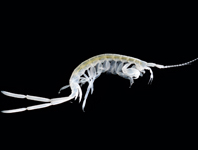Abstract
A new fossil isometopine species, Electromyiomma herczeki sp. nov. is described and illustrated from Eocene Baltic amber. The morphological information of the fossil specimen and the key to the species of the extinct genus Electromyiomma are provided. The restatement of paratype female of E. weitschati is discussed with the support of previous remarks based on antenna structure.
References
Bogri, A., Solodovnikov, A. & Żyła, D. (2018) Baltic amber impact on historical biogeography and palaeoclimate research: oriental rove beetle Dysanabatium found in the Eocene of Europe (Coleoptera, Staphylinidae, Paederinae). Papers in Palaeontology, 4 (3), 433–452.
https://doi.org/10.1002/spp2.1113.
Bukejs, A., Alekseev, V.I. & Pollock, D.A. (2019) Waidelotinae, a new subfamily of Pyrochroidae (Coleoptera: Tenebrionoidea) from Baltic amber of the Sambian peninsula and the interpretation of Sambian amber stratigraphy, age and location. Zootaxa, 4464 (2), 261–273.
https://doi.org/10.11646/zootaxa.4664.2.8
Cassis, G. & Schuh, R.T. (2012) Systematics, biodiversity, biogeography, and host associations of the Miridae (Insecta: Hemiptera: Heteroptera: Cimicomorpha). Annual Review of Entomology, 57, 377–404.
https://doi.org/10.1146/annurev-ento-121510-133533
Herczek, A. (1993) Systematic Position of Isometopinae Fieb. (Miridae, Heteroptera) and their interrelationships. Prace Naukowe Uniw. Śląskiego, Katowice, 86 pp.
Herczek, A. & Popov, Y.A. (1997) New peculiar representatives of the Isometopinae from the Baltic amber (Heteroptera: Miridae). Mitteilungen aus dem Geologisch-Paläeontologischen Institutder Universität Hamburg, 80, 189–195.
Herczek, A. & Popov, Y.A. (2012) A new peculiar isometopine genus (Hemiptera: Heteroptera: Miridae) from the Eocene Baltic amber. Zootaxa, 3196 (1), 64–68.
https://doi.org/10.11646/zootaxa.3196.1.4
Herczek, A. & Popov, Y.A. (2014) Revision of the genus Metoisops (Hemiptera: Heteroptera, Miridae, Isometopinae) from late Eocene European amber. Zootaxa, 3887 (3), 401–421.
https://doi.org/10.11646/zootaxa.3887.4.1
Herczek, A., Popov, Y.A. & Drohojowska, J. (2020) Isomyiomma hirta gen. et sp. n., a new peculiar plant bug (Hemiptera: Heteroptera: Miridae: Isometopinae) from late Eocene Baltic amber. Acta Zoologica cracoviensia, 63 (1), 15–19.
https://doi.org/10.3409/azc.63.03
Namyatova, A.A. & Cassis, G. (2016) Review of the seven new species of Isometopinae (Heteroptera: Miridae) in Australia and discussion of distribution and host plant associations of the subfamily on a worldwide basis. Austral Entomology, 55, 392–422.
https://doi.org/10.1111/aen.12202
Popov, Y.A. & Herczek, A. (1992) The first Isometopinae from Baltic Amber (Insecta: Heteroptera, Miridae). Mitteilungen aus dem Geologisch-Paläontologischen Institut der Universität Hamburg, 73, 241–258.
Schuh, R.T. (2002–2013) Online Systematic Catalog of Plant Bugs (Insecta: Heteroptera: Miridae). The American Museum of Natural History. Available from: http://research.amnh.org/pbi/catalog/ (accessed 17 December 2020)
Schuh, R.T. & Weirauch, C. (2020) True Bugs of the World (Hemiptera: Heteroptera). Classification and Natural History. 2nd Edition. Siri Scientific Press, Manchester, 800 pp.
Shavrin, A.V. & Yamamoto, S. (2019) Unexpected palaeodiversity of omaliine rove beetles in Eocene Baltic amber (Coleoptera, Staphylinidae, Omaliinae). Zookeys, 863, 35–83.
https://doi.org/10.3897/zookeys.863.34662
Szwedo, J. & Sontag, E. (2009) The traps of the ‘amber trap’. How inclusions could trap scientists with enigmas. Denisia, 26, 155–169.
Wappler T (2005) The age of Baltic amber: Could Eckfeld resolve this problem? In: Brothers, D. & Mostovski, M. (Eds.), Fossils X3. 3rd International Congress of Palaeoentomology with 2nd International Meeting on Palaeoarthropodology and 2nd World Congress on Amber and its Inclusions. Programme and Abstracts, 7–11 February 2005, Pretoria South Africa. University of Kwazulu-Natal, South African National Biodiversity Institute, Pretoria, pp. 53.
Zachos, J., Pagani, M., Sloan, L., Thomas, E. & Billups, K. (2001) Trends, rhythms, and aberrations in global climate 65 Ma to present. Science, 292, 686–693.


